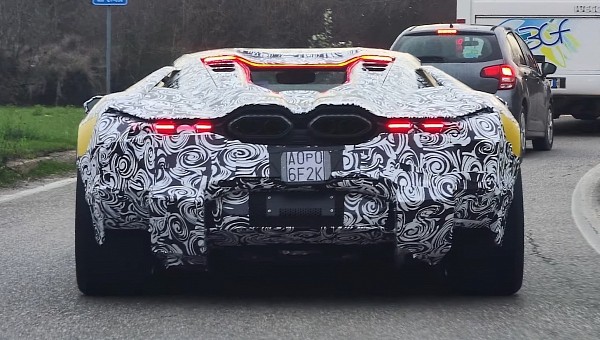Named after a Spanish fighting bull, the Aventador sadly left us for greener pastures in 2022. It was about time, to be frank, considering that Lamborghini started making the V12-engined supercar in February 2011.
Just under 11,500 units were delivered in this period, making it Lambo’s best-selling V12 flagship to date. Penned by Filippo Perini and restyled by Mitja Borkert, the Aventador introduced Lamborghini’s first all-new V12 after the long-lived original from the 1960s. It also introduced mild-hybrid assistance to the Raging Bull’s lineup, but as you’ll find out later this year, mild hybridization is nothing more than a stopgap for the Italian marque.
Expected to debut in 2023 for the 2024 model year, the yet-unnamed successor is plug-in hybrid. Not any kind of plug-in hybrid, though, but an e-AWD monster with an electric front axle and a naturally-aspirated V12, located behind the driver’s back. Already confirmed to be a clean-sheet design, the V12 in question will carry forward Giotto Bizzarrini’s legacy.
Recently leaked by design patent images from the European Union Intellectual Property Office, the newest bull on the block has been spied testing with less camouflage than ever before. Finished in a beautiful shade of yellow, the prototype in the video below also shows production-spec body panels and one of the coolest third brake lights in the industry.
Spied by carparazzo Varryx near the Sant’Agata Bolognese factory, the production-ready supercar features an intricate rear bumper that combines design for design’s sake with aerodynamic trickery. You can further notice quad pipes arranged in two hexagonal finishes, with said exhaust layout flanked by slim LED taillights. The black-and-white camouflage doesn’t show how much said taillights extend to the rear bumper’s sides, though.
Two flying buttresses loosely inspired by those of the Ferrari 599 GTB Fiorano are present as well, along with a pair of vents and a rather interesting rear deck. The rearmost part of the rear deck appears to be an airbrake of sorts. When flush with the rest of the rear deck, downforce is limited for the sake of top speed. With it up at an angle, the downforce created by the airbrake improves both stability and braking performance.
As opposed to the Aventador, there is no mechanical connection between the front and rear axle to speak of. The electric drive unit up front should work independently from the combustion engine, when needed, for a performance boost, improved traction, and even a few zero-emission kilometers based on the battery’s capacity. In EV mode, the heir apparent of the Aventador is front-wheel drive. Now let that sink in for a minute…
You’re good? Good! Regarding the high-voltage battery, chances are that Lamborghini will use the central tunnel as much as possible. Chevrolet does it, too, with the newly introduced Corvette E-Ray, which sports 1.9 kWh because it’s a hybrid. The Lambo is a plug-in hybrid, so it’s likely to find a few more cells in other parts of the car, beyond the central tunnel.
And now, for the most Top Trumps question of them all. How much horsepower is hiding under there? We sadly do not know, but guesstimate at least 1,000 hybridized ponies. The yardstick the all-new flagship has to beat is the Ferrari SF90 Stradale, which produces 1,000 ps and 800 Nm from a three-motor and twin-turbo V8 powertrain. Over in the U.S., make that 986 mechanical ponies and 590 pound-feet of twist.
Expected to debut in 2023 for the 2024 model year, the yet-unnamed successor is plug-in hybrid. Not any kind of plug-in hybrid, though, but an e-AWD monster with an electric front axle and a naturally-aspirated V12, located behind the driver’s back. Already confirmed to be a clean-sheet design, the V12 in question will carry forward Giotto Bizzarrini’s legacy.
Recently leaked by design patent images from the European Union Intellectual Property Office, the newest bull on the block has been spied testing with less camouflage than ever before. Finished in a beautiful shade of yellow, the prototype in the video below also shows production-spec body panels and one of the coolest third brake lights in the industry.
Spied by carparazzo Varryx near the Sant’Agata Bolognese factory, the production-ready supercar features an intricate rear bumper that combines design for design’s sake with aerodynamic trickery. You can further notice quad pipes arranged in two hexagonal finishes, with said exhaust layout flanked by slim LED taillights. The black-and-white camouflage doesn’t show how much said taillights extend to the rear bumper’s sides, though.
Two flying buttresses loosely inspired by those of the Ferrari 599 GTB Fiorano are present as well, along with a pair of vents and a rather interesting rear deck. The rearmost part of the rear deck appears to be an airbrake of sorts. When flush with the rest of the rear deck, downforce is limited for the sake of top speed. With it up at an angle, the downforce created by the airbrake improves both stability and braking performance.
As opposed to the Aventador, there is no mechanical connection between the front and rear axle to speak of. The electric drive unit up front should work independently from the combustion engine, when needed, for a performance boost, improved traction, and even a few zero-emission kilometers based on the battery’s capacity. In EV mode, the heir apparent of the Aventador is front-wheel drive. Now let that sink in for a minute…
You’re good? Good! Regarding the high-voltage battery, chances are that Lamborghini will use the central tunnel as much as possible. Chevrolet does it, too, with the newly introduced Corvette E-Ray, which sports 1.9 kWh because it’s a hybrid. The Lambo is a plug-in hybrid, so it’s likely to find a few more cells in other parts of the car, beyond the central tunnel.
And now, for the most Top Trumps question of them all. How much horsepower is hiding under there? We sadly do not know, but guesstimate at least 1,000 hybridized ponies. The yardstick the all-new flagship has to beat is the Ferrari SF90 Stradale, which produces 1,000 ps and 800 Nm from a three-motor and twin-turbo V8 powertrain. Over in the U.S., make that 986 mechanical ponies and 590 pound-feet of twist.















































